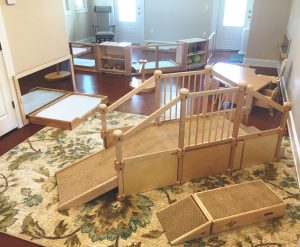Scientific observation then has established that education is not what the teacher gives; education is a natural process spontaneously carried out by the human individual and is acquired not by listening to words but by experiences upon the environment.” ~ Dr. Maria Montessori, Education for a New World
 Learning is facilitated in our comfortable, home-like setting which is attentively filled with developmentally appropriate materials that contribute to the growth of self-motivated, independent children. Each class contains a range of ages and abilities; more experienced children share what they have learned with younger children, who in turn enjoy the daily stimulation of older role models. These peer teachers help others by reinforcing their own skills and experiences by the responsibilities of leadership. Children care for each other in a warm atmosphere of acceptance and joy; adults consciously and delicately nurture the development through their caring and compassionate characters.
Learning is facilitated in our comfortable, home-like setting which is attentively filled with developmentally appropriate materials that contribute to the growth of self-motivated, independent children. Each class contains a range of ages and abilities; more experienced children share what they have learned with younger children, who in turn enjoy the daily stimulation of older role models. These peer teachers help others by reinforcing their own skills and experiences by the responsibilities of leadership. Children care for each other in a warm atmosphere of acceptance and joy; adults consciously and delicately nurture the development through their caring and compassionate characters.
Each class operates on the principle of responsible “freedom within limits.” Children are free to work at their own pace, alone or with others. We encourage a balance of active, self-directed learning with small group collaboration and peer teaching, so that children will problem-solve, see natural connections in knowledge, and create new ideas. Children in this environment learn to make decisions at an early age, to reason, cooperate, negotiate, reflect, and understand. Through direct experience and the process of discovery and investigation, children learn most effectively – and attitudes toward learning remain positive and enthusiastic, not overwhelming.
PHILOSOPHY OF EDUCATION
Montessori education is a philosophy with the fundamental tenet that a child learns best within a social environment that supports each child’s unique development.
Maria Montessori, M.D., the founder and developer of what is called “The Montessori Method of Education,” based this new education on her scientific observations of young children’s behavior. As the first woman physician to graduate from the University of Rome, Dr. Montessori became involved with education as a doctor treating children. Then in 1907, she was invited to open a childcare center for the children of desperately poor families in the San Lorenzo slums of Rome. She called it “a children’s house,” and based the program on her observations that young children learn best in a home-like setting filled with developmentally appropriate materials that provide experiences contributing to the growth of self-motivated, independent learners.
Dr. Montessori carried her training throughout the world, including the United States, as early as 1912.
Dr. Montessori’s dynamic theories included such revolutionary premises as:
- Children are to be distinctly respected as individuals that differ from one another.
- Children create themselves through purposeful activity.
- The most important years for learning are from birth to age six.
- Children possess unusual sensitivity and mental powers for absorbing and learning from their environment, which includes people as well as materials.
 Dr. Montessori developed what she called the “prepared environment,” which possesses a certain order and allows children to learn at their own development, in a non-competitive atmosphere. Dr. Montessori also recognized that the only valid impulse to learning is the self-motivation of the child; children move themselves toward learning. The teacher prepares the environment, directs the activity, and offers the child stimulation, but it is the child who learns and is motivated through work itself to persist in a given task. If Montessori children are free to learn, it is because they have acquired an “inner discipline” from their exposure of both physical and mental order. This is the core of Dr. Montessori’s philosophy. Social adjustment, though a necessary condition of learning in a traditional classroom, is not the purpose of education.
Dr. Montessori developed what she called the “prepared environment,” which possesses a certain order and allows children to learn at their own development, in a non-competitive atmosphere. Dr. Montessori also recognized that the only valid impulse to learning is the self-motivation of the child; children move themselves toward learning. The teacher prepares the environment, directs the activity, and offers the child stimulation, but it is the child who learns and is motivated through work itself to persist in a given task. If Montessori children are free to learn, it is because they have acquired an “inner discipline” from their exposure of both physical and mental order. This is the core of Dr. Montessori’s philosophy. Social adjustment, though a necessary condition of learning in a traditional classroom, is not the purpose of education.
The years between birth and six are the crucial years in which children learn the rules of human behavior most easily. These years can be constructively devoted to teaching the child good manners and habits, so that they may take their place in society.
Patterns of concentration, established in early childhood, produce a confident, competent learner in later years. The Montessori teaching method teaches children to observe, think, and judge. It introduces children to the joy of learning at an early age and provides a framework in which intellectual and social disciplines go hand-in-hand.
WHAT MAKES MONTESSORI EDUCATION UNIQUE?
- The Whole Child Approach: The primary goal of a Montessori program is to help each child reach their full potential in all areas of life. Activities promote the development of social skills, emotional growth, and physical coordination, as well as cognitive preparation. The holistic curriculum, under the direction or a specially prepared teacher, allows the child to experience the joy of learning, time to enjoy the process, and ensures the development of self-esteem. This curriculum also provides the experiences from which children create their knowledge.
- The ‘Prepared Environment’: In order for self-directed learning to take place, the whole learning environment –room, materials, and social climate- must be supportive of the learner. The teacher provides the necessary resources, including opportunities for children to function in a safe and positive climate. The teacher thus gains the children’s trust, which enables them to try new things and builds self-confidence.
- The Montessori Materials: Dr. Montessori’s observations regarding the sorts of things which children enjoy, and go back to repeatedly, led her to design a number of multi-sensory, sequential, and self-correcting materials, which facilitate the learning of skills and lead to the learning of abstract ideas.
- The Teacher: The Montessori teacher functions as a guide within the environment, a role model, a demonstrator, a record-keeper, and a meticulous observer of each child’s behavior and development. The teacher operates as a facilitator of education for the whole child. A fully certified Montessori teacher must have as a minimum, a B.S. or B.A. degree followed by extensive Montessori training, and then complete a one-year internship in a Montessori classroom that is age-appropriate for their training.
- How Does It Work?
Every program has its set of ground rules which differs from age to age, but is always based on the core Montessori philosophy: respect for oneself, one another, and for the environment. Children are free to work at their own pace with materials they have chosen, either alone or with others. The teacher relies on his or her observation of the children to determine which new activities and materials he or she may introduce to an individual child or to a small or large group. The aim is to encourage active, self-directed learning and to strike a balance of individual and small group collaboration within the whole group community.
The age span in each class provides a family-like grouping where learning can take place naturally. More experienced children share what they have learned while reinforcing their own learning. Because this peer group learning is intrinsic to Montessori, there is often more conversation, and more language experiences, in the Montessori classroom then in a traditional early education setting.
- What Happens When A Student Leaves Montessori?
Montessori children are unusually adaptable. They have learned to work independently and in groups. Because they’ve been urged to make decisions from an early age, these children are problem-solvers who can make choices and manage their time well.
They have also been encouraged to exchange ideas and to discuss their work freely, utilizing good communication skills while easing their way into a new setting.
A significant predictor of future success is a strong sense of self-esteem, and Montessori programs, based on self-directed, non-competitive activities, help children develop a positive self-image and the confidence to face challenges and change with optimism.